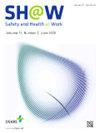Health Challenges Among Waste Collectors in Bangladesh: Exploring Risk Factors Using Multi-level Modeling
IF 2.9
3区 医学
Q1 PUBLIC, ENVIRONMENTAL & OCCUPATIONAL HEALTH
引用次数: 0
Abstract
Background
Waste collectors face multi-faceted health risks including exposure to musculoskeletal disorders, respiratory diseases, and workplace injuries because of their hazardous work environment. The purpose of this study was to determine the risk factors that affect health of the waste collectors across Bangladesh.
Methods
Data on a cross-sectional survey obtained information from 481 waste collectors about their demographics, housing conditions, hygiene practices, security measures, and disease prevalence. Descriptive analyses and multi-level models are used.
Results
As per univariate analysis, 81.3% did not have access to clean water, 58.4% did not have access to sanitation, and 65.9% of people lived in unhealthy housing. According to bivariate analysis, there is an association between unhealthy working conditions i.e., respiratory illnesses (19.1% asthma, 29.7% cough), gastrointestinal issues (59.3% discomfort, 24.1% diarrhea), musculoskeletal disorders, and dermatological diseases, and unsafe working conditions (i.e., 60% no masks, 71% no gloves, and 75% no boots). Considering geographic clustering, multi-level modeling examined how different factors affected particular illnesses. The following were significant protective factors: better housing (80% lower odds of acute irritation), security measures (50% lower odds of gastrointestinal diseases), good hygiene (62% lower odds of dermatological diseases), and younger age (2% higher odds of respiratory diseases per year).
Conclusion
In summary, unsafe living and working conditions greatly push the risks of illness for waste collectors. These risks to occupational health can be reduced with targeted interventions that enhance housing, hygiene, security protocols, and working conditions.
孟加拉国废物收集者的健康挑战:利用多层次模型探索风险因素
背景:废物收集者面临多方面的健康风险,包括接触肌肉骨骼疾病、呼吸系统疾病和工作场所伤害,因为他们的危险工作环境。这项研究的目的是确定影响孟加拉国各地废物收集者健康的风险因素。方法通过横断面调查获得481名垃圾收集者的人口统计、住房条件、卫生习惯、安全措施和疾病流行情况等信息。使用了描述性分析和多级模型。结果根据单变量分析,81.3%的人无法获得清洁水,58.4%的人无法获得卫生设施,65.9%的人居住在不健康的住房中。根据双变量分析,不健康的工作条件,即呼吸系统疾病(19.1%哮喘,29.7%咳嗽)、胃肠问题(59.3%不适,24.1%腹泻)、肌肉骨骼疾病和皮肤病,与不安全的工作条件(即60%不戴口罩,71%不戴手套,75%不穿靴子)之间存在关联。考虑到地理聚类,多层次模型研究了不同因素如何影响特定疾病。以下是重要的保护因素:更好的住房(急性刺激的几率降低80%)、安全措施(胃肠道疾病的几率降低50%)、良好的卫生(皮肤病的几率降低62%)和更年轻的年龄(每年呼吸系统疾病的几率高2%)。综上所述,不安全的生活和工作条件大大增加了垃圾收集者的疾病风险。通过有针对性的干预措施,改善住房、卫生、安全协议和工作条件,可以减少这些职业健康风险。
本文章由计算机程序翻译,如有差异,请以英文原文为准。
求助全文
约1分钟内获得全文
求助全文
来源期刊

Safety and Health at Work
Social Sciences-Safety Research
CiteScore
6.40
自引率
5.70%
发文量
1080
审稿时长
38 days
期刊介绍:
Safety and Health at Work (SH@W) is an international, peer-reviewed, interdisciplinary journal published quarterly in English beginning in 2010. The journal is aimed at providing grounds for the exchange of ideas and data developed through research experience in the broad field of occupational health and safety. Articles may deal with scientific research to improve workers'' health and safety by eliminating occupational accidents and diseases, pursuing a better working life, and creating a safe and comfortable working environment. The journal focuses primarily on original articles across the whole scope of occupational health and safety, but also welcomes up-to-date review papers and short communications and commentaries on urgent issues and case studies on unique epidemiological survey, methods of accident investigation, and analysis. High priority will be given to articles on occupational epidemiology, medicine, hygiene, toxicology, nursing and health services, work safety, ergonomics, work organization, engineering of safety (mechanical, electrical, chemical, and construction), safety management and policy, and studies related to economic evaluation and its social policy and organizational aspects. Its abbreviated title is Saf Health Work.
 求助内容:
求助内容: 应助结果提醒方式:
应助结果提醒方式:


